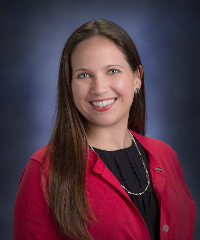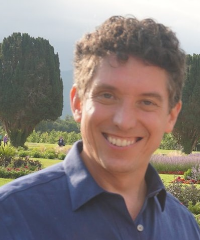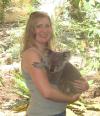Community Blogs
Community Blogs
Discover how the GLOBE community is engaging in all things GLOBE through the community blog posts below.
Learn how to create a GLOBE community blog post.
Filter By:
Blogs List
Do you live in an area that has dust storms? The Global Learning and Observations to Benefit the Environment Program (GLOBE) team would like you to photograph dust events in your area and submit your photos using the GLOBE Observer app .
Join NASA GLOBE Clouds Project Scientist, Marilé Colón Robles, to learn more about how to collect your observations and educational resources you can use with formal and informal audiences. Your observations will be used by scientists to verify satellite observations and see if their models have successfully predicted these ...
Read More »
Posted in:
Curriculum:
EDUCATION RESEARCH
SCIENCE AND MATH
TECHNOLOGY
Event Topics:
CAMPAIGNS AND PROJECTS (IOPS, ETC)
GLOBE Science Topics:
GENERAL SCIENCE
CLIMATE CHANGE
DATA INCLUDED
BACKYARD SCIENCE
CLIMATE
EARTH AS A SYSTEM
SCIENTIST SKILLS
GLOBE PROTOCOLS
GLOBE Working Groups:
EDUCATION WORKING GROUP
SCIENCE WORKING GROUP
Investigation Areas:
ATMOSPHERE
PEDOSPHERE (SOIL)
Learning Activities:
ATMOSPHERE AND CLIMATE
SOIL
News Topics:
CALENDAR
TRAINING
Primary Audience:
PARTNERS
SCIENTISTS
ALUMNI
COUNTRY COORDINATORS
TRAINERS
TEACHERS
STUDENTS
Teacher's Guide:
GRADE LEVELS
INVESTIGATION AREA DOCUMENTS
The NASA GLOBE Clouds team is looking for members of the GLOBE International STEM Network (GISN) or any researcher that would be interested in publishing research (as lead or co-author) using the GLOBE Clouds data.
We are looking for researchers that are interested in:
Cryosphere that would be willing to use cloud observations over the Arctic/Antarctica.
Satellite validation studies with collocated observations, particularly those collected during GLOBE Clouds Data Challenge (March 15-April 15, 2018).
Natural hazards to explore ...
Posted in:
Event Topics:
OTHER
GLOBE Science Topics:
CLIMATE CHANGE
DATA INCLUDED
EARTH SYSTEM SCIENCE
BACKYARD SCIENCE
CLIMATE
GLOBE PROTOCOLS
GLOBE Working Groups:
SCIENCE WORKING GROUP
Primary Audience:
SCIENTISTS
I just updated HoloGLOBE to v1.0.2. For those of you new to this app, HoloGLOBE brings NASA and NOAA visualizations of the Earth to the palm of your hand through augmented reality (AR). You can read more about the app here: http://www.palmyracove.org/InstituteforEarthObservations/HoloGLOBE.aspx
In this latest release, I have added play/pause functionality to the MyNASAData module. The MyNASAData is essentially an augmented reality version of GLOBE's Earth System Poster. In addition the new ICESat-2 module has been added. The ICESat-2 module was built by Emme Wiederhold, a ...
Posted in:
Curriculum:
STEM
ASSESSMENT AND EVALUATION
EDUCATION RESEARCH
LANGUAGE CULTURE AND ARTS
SCIENCE AND MATH
TECHNOLOGY
Event Topics:
CAMPAIGNS AND PROJECTS (IOPS, ETC)
GLOBE LEARNING EXPEDITIONS
OTHER
SCIENCE SYMPOSIA AND FAIRS
MEETINGS
WORKSHOPS
COMPETITIONS
Field Campaigns:
SCRC - PHASE 2
SCRC
FLEXE
CARBON CYCLE
WATERSHEDS
SEASONS AND BIOMES
SCUBANAUTS
EL NIÑO
GGIC
SCRC - PHASE 1
SMAP
SURFACE TEMPERATURE
GPM
GLOBE Science Topics:
EARTH SYSTEM SCIENCE
GENERAL SCIENCE
GENERAL SCIENCE @ES
CLIMATE CHANGE
DATA INCLUDED
BACKYARD SCIENCE
MEETINGS/CONFERENCES
CLIMATE
SCIENTIST SKILLS
EARTH AS A SYSTEM
GLOBE PROTOCOLS
GLOBE Working Groups:
EVALUATION WORKING GROUP
SCIENCE WORKING GROUP
EDUCATION WORKING GROUP
TECHNOLOGY WORKING GROUP
Investigation Areas:
BIOSPHERE
ATMOSPHERE
EARTH AS A SYSTEM
HYDROSPHERE
PEDOSPHERE (SOIL)
Learning Activities:
EARTH AS A SYSTEM
ATMOSPHERE AND CLIMATE
LAND COVER/BIOLOGY
HYDROLOGY
SOIL
News Topics:
VIRTUAL SCIENCE FAIR
IOPS
REGIONS
CALENDAR
SCRC RESEARCH
TRAINING
COMPETITIONS
MEETINGS
VIDEO
WEB MAINTENANCE / ENHANCEMENTS
Primary Audience:
PARTNERS
SCIENTISTS
ALUMNI
COUNTRY COORDINATORS
TRAINERS
TEACHERS
STUDENTS
Teacher's Guide:
GRADE LEVELS
DOCUMENT TYPES
TIME REQUIREMENTS
LANGUAGES
STANDARDS REQUIREMENTS
INVESTIGATION AREA DOCUMENTS
From the start, the measurement of daily maximum and minimum air temperature within one hour of local solar noon has been a key GLOBE protocol. The low cost approach was to use a U-tube thermometer housed in a wooden instrument shelter facing away from the equator. The U-shaped tube contained mercury with pins on either side of the mercury. As the air temperature warmed the pin on one side would move while the other pin stayed in place; when the air cooled, the pin on the other side would be pushed up. The pins were held in place by magnetized strips behind the thermometer tube so that ...
Posted in:
Curriculum:
STEM
TECHNOLOGY
GLOBE Science Topics:
EARTH AS A SYSTEM
EARTH SYSTEM SCIENCE
GLOBE PROTOCOLS
CLIMATE CHANGE
CLIMATE
GLOBE Working Groups:
SCIENCE WORKING GROUP
Investigation Areas:
ATMOSPHERE
Primary Audience:
TEACHERS
TRAINERS
STUDENTS
PARTNERS
SCIENTISTS
ALUMNI
COUNTRY COORDINATORS
As Earth science has a single uncontrolled object of study, the first rule is to take today’s data today. While ice and sediment cores and fossils can reveal past conditions, the observations that can be made right now cannot be replaced by ones taken later. This goes well with the Native American adage, “You can’t step in the same river twice.” The environment is constantly changing and doing so on a wide range of time and space scales.
In a recent video post, Neil deGrasse Tyson said,
“One of the great things about science is that it is an entire exercise finding what is true. You ...
Posted in:
Curriculum:
SCIENCE AND MATH
Event Topics:
CAMPAIGNS AND PROJECTS (IOPS, ETC)
GLOBE LEARNING EXPEDITIONS
SCIENCE SYMPOSIA AND FAIRS
Field Campaigns:
EL NIÑO
SMAP
GLOBE Science Topics:
EARTH AS A SYSTEM
EARTH SYSTEM SCIENCE
GENERAL SCIENCE
CLIMATE CHANGE
CLIMATE
Investigation Areas:
EARTH AS A SYSTEM
Primary Audience:
TEACHERS
STUDENTS
ALUMNI
Concerns regarding the impact of global warming on vector-borne diseases have intensified interest in the relationship between atmospheric factors and dengue fever incidence. Global climate change poses the threat of serious social upheaval, population displacement, economic hardships, and environmental degradation. Changes in temperature, rainfall and relative humidity have potential to enhance vector development, reproductive and biting rates, shorten pathogen incubation period and encourage adult longevity. In addition, changes in wind direction, velocity and frequency will have an ...
Posted in:
GLOBE Science Topics:
CLIMATE CHANGE
GLOBE PROTOCOLS
Investigation Areas:
HYDROSPHERE
Learning Activities:
HYDROLOGY
Primary Audience:
TEACHERS
STUDENTS
Beste mensen,
Het effect van de uitzonderlijk zachte winter op de natuur is ook bij de media niet onopgemerkt gebleven. In de uitzending van het KRO programma Brandpunt op zondag 16 maart komt het onderwerp aan bod. Zie http://gemi.st/KN_1656575 . Het item begint op 23:20. Verder zat ik op zondag 9 maart in het programma Jinek op Zondag. Dit is terug te zien op http://gemi.st/KN_1656819 . Tenslotte zat ik op woensdag 19 maart in het EO-programma 'Melk en Honing'. De uitzending is terug te bekijken op http://gemi.st/EO_101212300 .
Vriendelijke groeten,
Arnold
Posted in:
Field Campaigns:
SEASONS AND BIOMES
GLOBE Science Topics:
CLIMATE CHANGE
Learning Activities:
LAND COVER/BIOLOGY
Primary Audience:
TRAINERS
TEACHERS
STUDENTS
PARTNERS
SCIENTISTS
Blog originally posted on The GLOBE Scientists' Blog: http://blog.globe.gov/sciblog/2013/03/06/connecting-pollutants-and-air-temperature-in-the-maldives/
With climate change, there are many relationships that are understood, and many others that are not. Dr. Veerabhadran Ramanathan from The Scripps Institute in San Diego has spent the last fifteen years in the Maldives, a nation south of India that is comprised of over 1,200 islands, studying the relationship between air pollutants, cloud formation and air temperature.
The Maldives are a great location for ...
Posted in:
Field Campaigns:
CARBON CYCLE
GLOBE Science Topics:
GENERAL SCIENCE
CLIMATE CHANGE
CLIMATE
Investigation Areas:
ATMOSPHERE
A couple of years ago, I attended a seminar sponsored by the Climate and Global Dynamics Division (CGD) of the National Center for Atmospheric Research (NCAR) on how climate change is threatening the survival of wolverines ( Gulo gulo ). This scientist, Synte Peacock from CGD, painted a gloomy outlook for this ferocious creature after using a climate model to examine changes in spring snow cover and summer air temperatures. However, recent legislative proposals may make the future a little brighter.
A ...
Posted in:
GLOBE Science Topics:
CLIMATE
CLIMATE CHANGE
Blog originally posted on The GLOBE Scientists' Blog: http://blog.globe.gov/sciblog/2013/01/30/an-interesting-relationship-soil-temperature-and-climate-change/
It seems common place that warmer air temperature leads to warmer soil temperature. And while this relationship seems intuitive, the effect isn’t always studied, especially with respect to the response from microorganisms. That is why researchers are investigating what happens when the soil temperature increases.
An intricate network of soil microorganisms From: Commonwealth Scientific and ...
Blog originally posted on the GLOBE Scientists' Blog: http://blog.globe.gov/sciblog/2013/01/23/trees-in-trouble-what-affect-does-tree-mortality-have-on-climate-change/
Through our trees in trouble series, we’ve examined trees in the Sahel zone in Africa and the United States . This problem, climate change and dying trees, has been seen on every continent, the only exception being Antarctica, due to the lack of vegetation on the frozen continent. Scientists have recently found that there is an alarming loss rate of big, old trees, whose ages range ...
Posted in:
GLOBE Science Topics:
GENERAL SCIENCE
CLIMATE CHANGE
CLIMATE
Investigation Areas:
ATMOSPHERE
BIOSPHERE
Blog previously posted on The GLOBE Scientists' Blog: http://blog.globe.gov/sciblog/2013/01/16/a-tale-of-two-extremes/
Weather extremes have become a common theme in the news headlines the past few weeks. For example, nearly every part of the United States has been experiencing one of two extremes – either frigid cold or record-breaking high temperatures. Places like Arizona and California experienced below-freezing temperatures, which can have potential impacts on the crops grown in these typically balmy regions. In contrast, cities in the Southeast U.S., such as ...
Blog originally posted on the GLOBE Scientists' Blog: http://blog.globe.gov/sciblog/2012/12/19/the-chicken-and-egg-story-of-global-warming-and-extreme-droughts-a-lesson-on-climate-feedbacks/
I recently read that the extreme drought in western North America during 2000-2004 actually resulted in more carbon dioxide being released into the atmosphere. In the article in Nature Geoscience , it explained that such droughts can further enhance global warming. When a drought occurs, the plants wither and die and no longer uptake carbon dioxide (normally living plants serve as a ...
Posted in:
GLOBE Science Topics:
CLIMATE
CLIMATE CHANGE
Blog originally posted on The GLOBE Scientists' Blog: http://blog.globe.gov/sciblog/2012/11/14/esno-basics-what-is-it/
Through many posts here on the Scientists’ Blog, we, in one way or another, discuss ENSO. ENSO, or El Niño-Southern Oscillation, is a quasi-periodic climate pattern that occurs in the tropical Pacific Ocean. When the conditions change, the atmosphere responds in many different ways. In certain locations, it is cloudier and it rains more, while in others it’s clear and dry. Through our “ENSO Basics” series, we’ll take a look at ENSO ...
Blog originally posted on The GLOBE Scientists' Blog: http://blog.globe.gov/sciblog/2012/11/08/non-stationarity-new-vocabulary-for-a-changing-climate/
A few years ago I attended a workshop for early career scientists to discuss frontiers in integrated water-climate-society vulnerability and adaptation science. This interdisciplinary area of science focuses on the need for using scientific information to not only identify communities that are vulnerable to climate change, but to also help create effective approaches for communities to adapt to climate change. Since every ...
Posted in:
GLOBE Science Topics:
CLIMATE
CLIMATE CHANGE
Blog originally posted on the GLOBE Scientists' Blog: http://blog.globe.gov/sciblog/2012/11/01/full-circle-superior-part-iv-changing-superior-changing-industry/
This week we pick back up on our Full Circle Superior Series. In 2010 Mike Link and Kate Crowley chose to walk around the largest fresh water lake in the world – Lake Superior which has shoreline in both Canada and the United States. This 1555 mile/145 day walk was the first ever by a couple and the first to attempt to stay on the shoreline. Because Mike and Kate are educators in their sixties they wanted ...
Blog originally posted on The GLOBE Scientists' Blog: http://blog.globe.gov/sciblog/2012/10/05/xpedition-review-reflections-back-and-looking-ahead/
To say that the journey to the summit of Mt. Kilimanjaro was a success would not do justice to the wonderful personal and scientific experiences the team had. From taking the first steps toward the summit on Sunday 23 September to summiting the following week and boarding flights to return home, each team member gained something that will stay with them forever.
Collecting data in the rainforest ...
Blog originally posted on the GLOBE Scientists' Blog: http://blog.globe.gov/sciblog/2012/10/04/xpedition-day-ten-mweka-camp-to-park-gate/
Monday, 1 October was the final day of The Xpedition. After an exciting summit day, the team continues on their descent and is picked up to head back to Arusha, where they will enjoy a well-deserved meal.
Unloading the equipment after a successful trip
Throughout the entire journey, the team relied on the use of porters, who are local Tanzanians who carry equipment up the mountain. These porters are essential to a ...
Blog originally posted on The GLOBE Scientists' Blog: http://blog.globe.gov/sciblog/2012/10/03/xpedition-day-nine-special-crater-camp-to-summit-to-mweka-camp/
On Sunday, 30 September, the team made it to the summit of Mt. Kilimanjaro. The summit sits at 5,895 m (19,340 ft) above sea level. What a fantastic accomplishment for the team!
Team at the summit
Hiking on a glacier near the summit
After the team spendt time celebrating their success, they began their descent, stopping at 3,200 m (10,498 ft) at Mweka Camp. To celebrate the ...
Blog originally posted on The GLOBE Scientists' Blog: http://blog.globe.gov/sciblog/2012/10/01/xpedition-day-eight-kosovo-camp-to-special-crater-camp/
As you may have noticed, the Scientist Blog was quiet for the past two days. As is to be expected, things can change rapidly on the mountain and the ability for the team to send us their daily blogs was interrupted. The team safely continued on their journey, and have sent us their blogs.
Day Eight was Saturday, 29 September. The team journeyed from 4,877 m (16,000 ft) to 5,608 m (18,399 ft). ...
—
20 Items per Page












